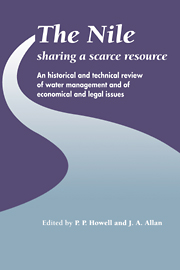 The Nile: Sharing a Scarce Resource
The Nile: Sharing a Scarce Resource Book contents
- Frontmatter
- Contents
- Preface
- List of Contributors
- Orthography
- Units and Conversion Factors
- Introduction
- I Environmental history of the Nile and its management
- II Nile management and factors affecting future management
- 6 Global climate change and the Nile Basin
- 7 Hydrological data requirements for planning Nile Management
- III Future utilisation of Nile waters
- IV Economic, international and legal issues
- Index
6 - Global climate change and the Nile Basin
Published online by Cambridge University Press: 05 February 2012
- Frontmatter
- Contents
- Preface
- List of Contributors
- Orthography
- Units and Conversion Factors
- Introduction
- I Environmental history of the Nile and its management
- II Nile management and factors affecting future management
- 6 Global climate change and the Nile Basin
- 7 Hydrological data requirements for planning Nile Management
- III Future utilisation of Nile waters
- IV Economic, international and legal issues
- Index
Summary
Introduction
Precipitation over the Nile Basin, and consequently Nile discharge, has fluctuated both historically and pre-historically. Precipitation zones have migrated latitudinally over the middle Nile by as much as 600 km over the last 20,000 years. Within the twentieth century, decadal precipitation changes have been up to 20 per cent of these Holocene changes. Our current understanding of precipitation over the Nile Basin suggests its sensitivity to a variety of factors operating on different time and space scales. These factors include changes in the Earth's orbit, global ocean temperature anomalies, migrations of the Inter-Tropical Convergence Zone, and land-cover changes within the African continent. Future global climate, however, may be subject to a new anthropogenic forcing, the impact of which on precipitation over northeast Africa, and hence Nile discharge, is still poorly understood, namely, progressive increases in the global atmospheric concentration of greenhouse gases.
This chapter presents a range of climate scenarios specifying the likely magnitudes and rates of change in Nile Basin precipitation over the next few decades. These scenarios are constructed from historical analogues, recent instrumental data, and General Circulation Model experiments. It is suggested that twentieth century precipitation characteristics are unlikely to be a reliable guide to twenty-first century precipitation. Relative contributions to Nile discharge from the Blue and While Niles may change, and increased evaporative water loss may be as important for assessing future Nile discharge as changes in precipitation.
- Type
- Chapter
- Information
- The Nile: Sharing a Scarce ResourceA Historical and Technical Review of Water Management and of Economical and Legal Issues, pp. 139 - 162Publisher: Cambridge University PressPrint publication year: 1994
- 3
- Cited by
